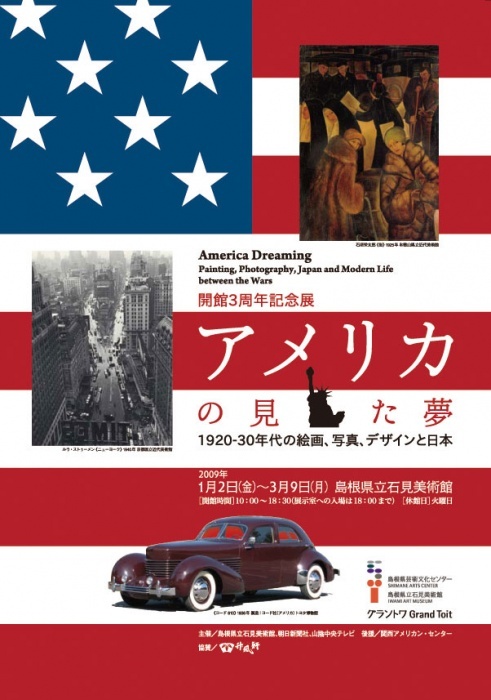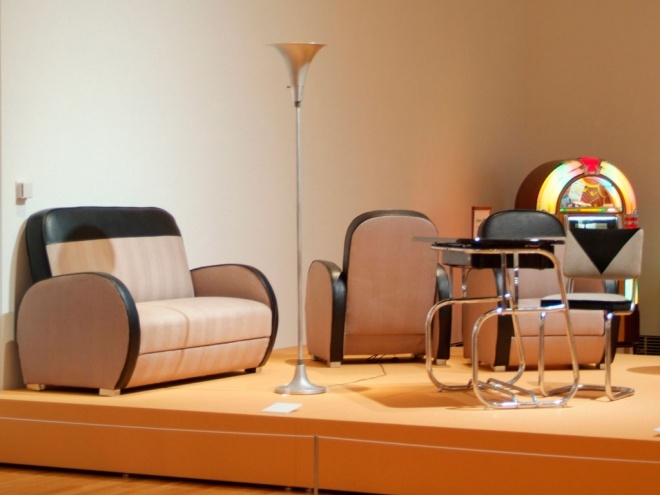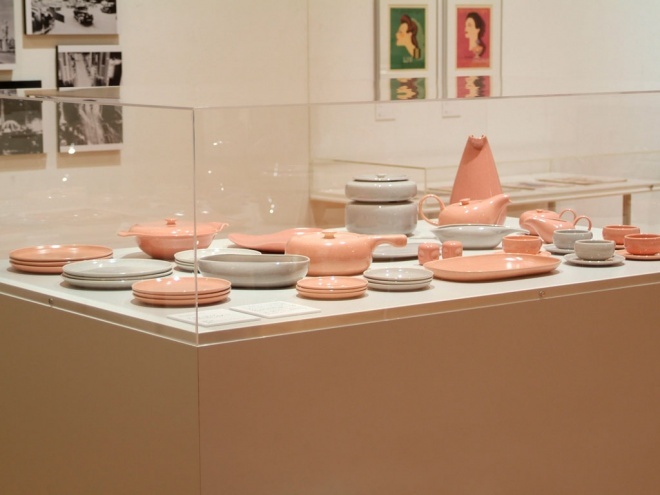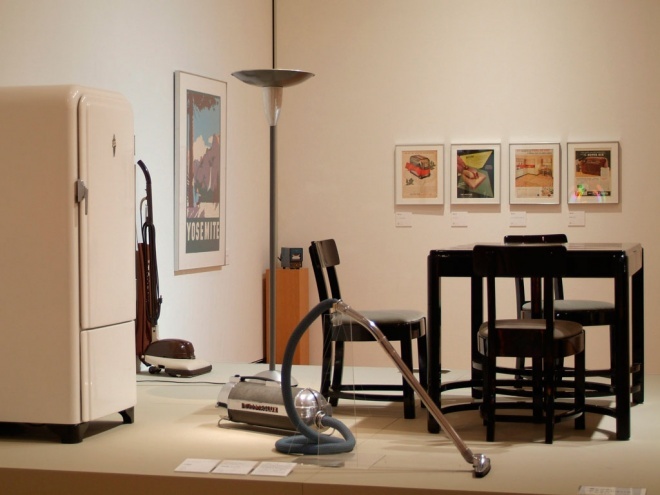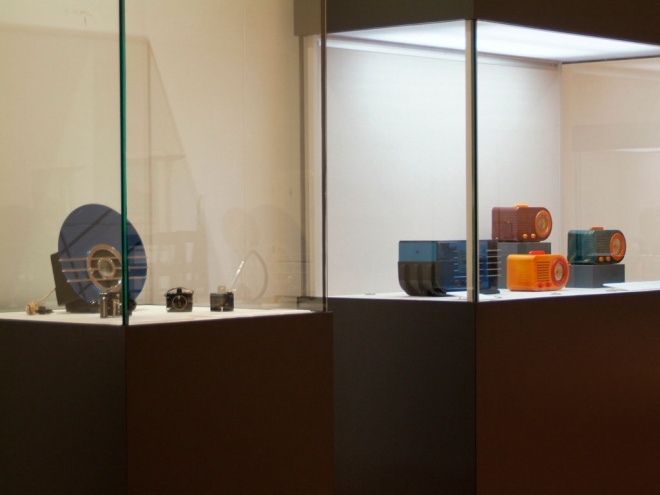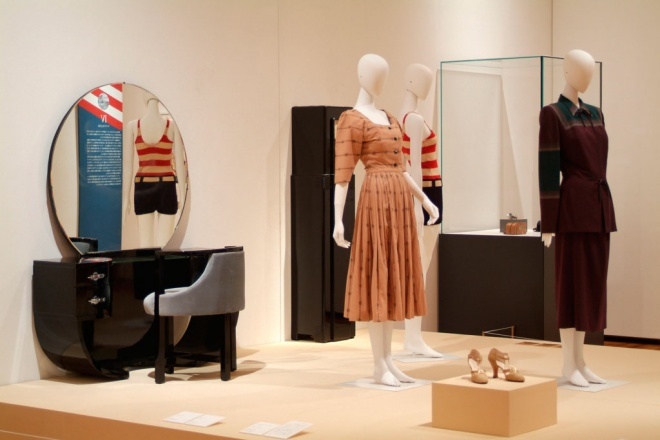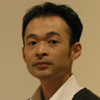- home>
- reports>
- news-report>
- American Design and Japan
| 2014.02.13 |
|
In the spring of 2009, an exhibition titled “America Dreaming: Painting, Photography, Japan and Modern Life between the Wars” was held at the Iwami Art Museum, introducing the art and culture of the golden age in the United States. The International Design Center NAGOYA cooperated by loaning approximately 70 pieces from its Design Museum Collection.
After WWI, against the background of overwhelming economic power, a consumer society developed rapidly, and along with industrial expansion, a new culture flourished. In the prominent country that the United States had become, gathered exceptional artists and products from Europe and Japan. At the same time, Japanese industry was greatly influenced by this very important export market. In this exhibition, which sought to delineate the origins of the lifestyle of the time, American culture and Japanese-American exchange, the 1936 radio of Walter Dorwin Teague was one of many pieces from the collection of the International Design Center NAGOYA that was displayed. Through these magnificent specimens of design, as well as pieces of contemporary art, the aura of the era was revived. The power of that period is felt not only in the relationship between art and design. The exhibit also shed new light on the role of design in the culture and society that shape our lives, and on its relative importance.(IdcN)
American Design and Japan
The International Design Center NAGOYA possesses a valuable collection of pre-WWII American design. We held an exhibition highlighting this American period titled, “American Dreaming: Painting, Photograph, Japan and Modern Life between the Wars”. Borrowing many pieces from the Center’s and other collections, we put together an exhibition rich in content.
The period targeted by this exhibition, and that during which most of the pieces in the Center’s collection were made, was when the United States, having enjoyed great prosperity following WWI, fell into a depression after the global financial crisis of 1929. The great financial fluctuation in the United States led to a sudden expansion and refinement of the modern lifestyle, affecting the daily lives of Japanese citizens of the time. Household appliances spread to the point that even ordinary families had radios and refrigerators, and streamlined automobiles appeared on the streets. And industrial designers like Raymond Loewy and Norman Bel Geddes did some spectacular work.
From that point on, prosperous America became an important export market for Japanese products. For instance, the ceramics manufacturer Noritake stationed designers in the United States so that the company could mass produce popular tableware just a little more quickly than anyone else and export it to the U.S. Industrial arts like this became important export products for Japan, so much so that in 1928 the National Research Institute of Industrial Arts (NRIIA) was established. At the NRIIA, the organization for the country’s design policies, postwar designers like Isamu Kenmochi and Katsuhei Toyoguchi worked as staff, and when Germany’s Bruno Taut and France’s Charlotte Perriand came to Japan, they were also associated with the center.
Articles in the NRIIA’s bulletin, “Industrial Arts News”, regularly introduced American industrial design, accompanied by photographic illustrations of the convenient household appliances and streamlined automobiles of the time. From that period on, industrial products and their design garnered much attention in Japan. However, in the Japan of that time, there were no industrial designers of the caliber of the American ones. Japan longed for the American way of life, but it was not until after its defeat by the United States in the war that it followed America’s lead and became a major exporter of cars and household appliances.
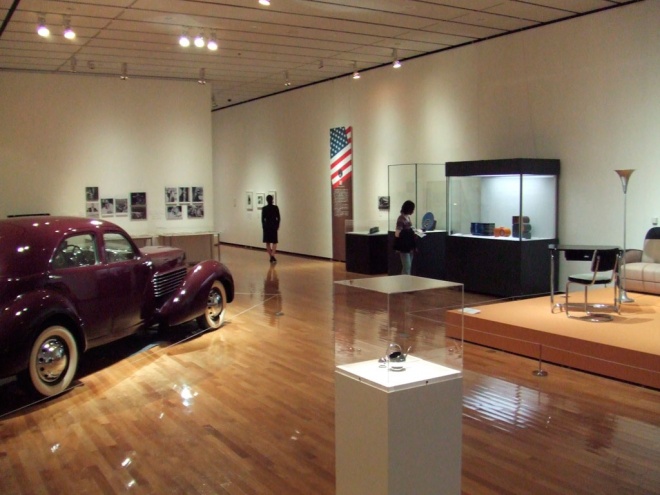
Iwami Art Museum the 3rd anniversary commemorative exhibition
America Dreaming:
Painting, Photography, Japan and Modern Life between the Wars
Period: Fri., January 2 2009 – Mon., March 9 2009
Venue: Iwami Art Museum
Organizers: Iwami Art Museum, Asahi Shimbun, San-in Chuo Television
Supporter: Kansai American Center
Sponsor: Tikufuuken
Katsuhiko Kawano
- Report: Nagoya, UNESCO City of Design Promotion Projects FY 2013
- Report: creators shop Loop(Fourth and Fifth Session)
- Report: 2013 Nagoya City Emergency Job Creation Projects
Creative Industry Cooperative Promotion Projects - Report: Corporate Support・Design Planning and Production FY 2013
- Report: IdcN Design Promotion FY 2013
- Report|Design Tour: Fun with the Classics at Yokiso’s Choshokaku
- Electric Media: The Age of Radio
- Ziggurat Design 30s “American Art Deco and Skyscrapers”
- “LIFE” | America: Birth of Photojournalism Magazine
- American AD of 1930s | Lifestyle and Products
- Electric Dream: Household Electric Appliance and Modern Life
- Posters from the 30s: Modern Life and Graphic Design

